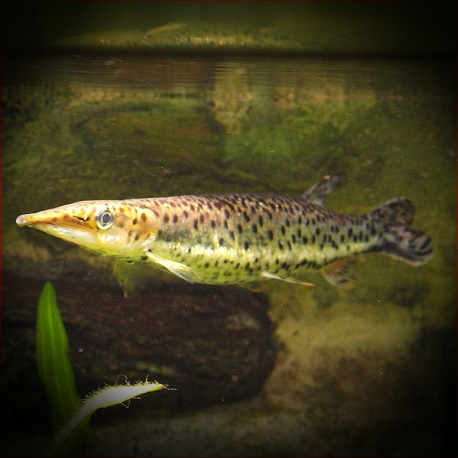More info
Datasheet
| Minimum Tank Size | 420 litres / 110.95 US gallons |
| Maximum Size | 32.9cm / 12.95inches |
| Temperature | 22°C / 71.60°F - 28°C / 82.40°F |
| Hardness | 1.01dgH / 18ppm - 12.05dgH / 215ppm |
| pH | 5.0-7.5 |
General Description
This species, known as Boulengerella Maculata, is characterized by various vernacular names such as 'Bicuda' or 'Uena' in Brazil, 'Picudo' in Ecuador and Peru, and 'Aguejeta' in Venezuela. It possesses distinct features such as a dorsal-fin base located mostly behind a vertical line through the anal-fin origin, thin dark horizontal stripes on the head, and a dark midlateral stripe on the body. B. maculata varies in coloration, with some specimens being paler than others, possibly influenced by water type rather than geographic distribution.
Aquarium Setup
For a proper aquarium setup for B. maculata, it is essential to provide surface cover like floating vegetation or branches. The fish thrives in high oxygen levels and moderate water movement, necessitating the use of external filters, powerheads, and airstones. Maintaining stable water conditions with weekly 30-50% water changes is crucial. Due to their jumping tendencies, a secure cover is necessary, and covering the back and sides of the aquarium can help reduce stress in this skittish species.
Behaviour
- B. maculata is peaceful towards larger tankmates but aggressive towards similarly aggressive or territorial species. It shows a schooling instinct in juveniles and tends to group in fours or more, even when older individuals become solitary.
Feeding and Diet
This obligate predator primarily feeds on smaller fishes and insects in its natural habitat but adapts well to dead food alternatives in captivity. Smaller specimens can be offered bloodworms, earthworms, and chopped prawns, while adults can consume fish flesh, shrimp, mussels, and live river shrimp. Avoid feeding mammalian or avian meat and 'feeder' fish to prevent dietary issues.
Reproduction & Dimorphism
Reproduction details of B. maculata are unrecorded, and no specific dimorphic features are highlighted for this species.
Habitat and Distribution
Adult B. maculata are pelagic and typically inhabit flowing stretches of main river channels, tributaries, and floodplain lakes within the Amazon, Orinoco, and Tocantins river systems. Their distribution spans Ecuador, Colombia, Peru, Brazil, and Venezuela, with slight variations in populations based on vertebral counts and lateral line scales.

